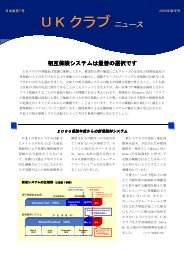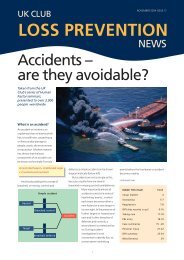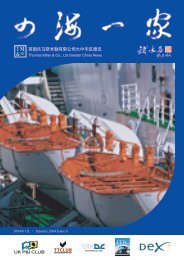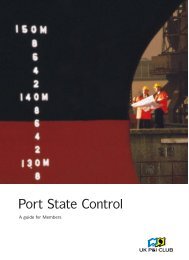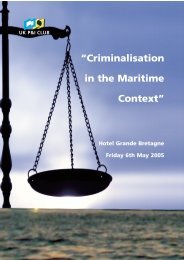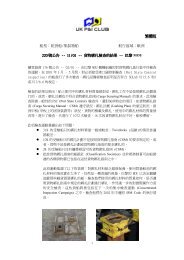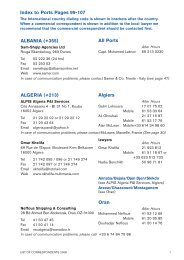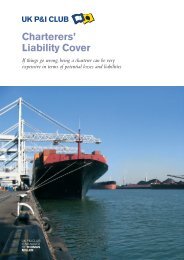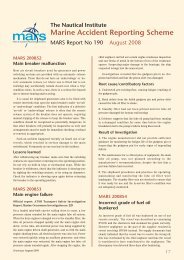Towage Guidance Note - UK P&I Members Area
Towage Guidance Note - UK P&I Members Area
Towage Guidance Note - UK P&I Members Area
- No tags were found...
You also want an ePaper? Increase the reach of your titles
YUMPU automatically turns print PDFs into web optimized ePapers that Google loves.
P&I coverage duringpost-casualty towage<strong>Towage</strong>, which is not part of ordinary or customary trading,requires planning. Owners need to consider the risks andunderstand the process required to maintain their P&I coverage
3covered. The Club Managers, like otherunderwriters, will usually rely on third partyexperts who issue tow approval certificates. TheClub may ask or suggest the Member to lay therisk off on the market, ie buy a separate policy forP&I risks during towage.Where the Club approves a contract, the scope ofP&I cover follows the normal Rules, such as injury,pollution or cargo aspects. P&I cover for towagedoes not expand to take on losses not in the regularP&I Club rules, such as commercial losses, loss ofprofit, physical damage to the ship, costs of towageor other liabilities not normally covered.It is good practice to seek the Club’s advancewritten agreement to provide coverage for a plannedtow, regardless of the form of contract, approvalsfrom various authorities, comments of Class or thereport of the approved Warranty Surveyor.Roles in “usual” casualties – Hullarranging towageWhen towing a vessel to a yard, an owner and hisHull underwriter will generally focus on the costof repair and value of the ship. The financialcalculus is that the residual value in the ship justifiesthe cost of towing and repairing it. If not, the shipis abandoned as a Constructive Total Loss CTL, ora wreck. Regular P&I cover includes wreckremoval costs if an order of removal is issued.For ships worth being brought to a repair yard, theHull underwriter will typically cover the costsrelating to the tow. Depending on the tug marketat the time, owners may have little choice when itcomes to the financial terms of the contract. Towingcontractors are likely to push for a lumpsumcontract, unless they deem the tow or towedvoyage to be problematic when they may thenoffer a daily rate. Contractors will usually offer acertain amount of freetime before which paymentsare due. This time is generally limited and ownersshould therefore try to ensure that preparations forthe towage of their vessel meet with all Warrantyrequirements before the arrival of the tug.Salvage and contractual towagedistinctionsSalvage can be described as being the workrequired to save a vessel and cargo. Under LOF thesalvor is required to use “best endeavours” to savethe vessel and cargo and re-deliver the vessel backto owners “safely afloat” at the agreed place ofsafety under the LOF. If no place of safety has beenagreed, Salvors have an obligation to deliver thevessel to a place of safety. Once the salved ship isdelivered back to the owner, at the agreed place ofsafety, salvage services legally end. Preparation foronward towage to another destination, does notform part of the salvage services contracted underthe LOF. “Safely afloat” can be defined as the vesselbeing in a safe condition, notwithstanding that thevessel may be damaged, and the continuation ofskilled salvage services from Salvors is no longernecessary to avoid the vessel from becoming lost orsignificantly further damaged. Futhermore, “safelyafloat” generally means that there is no requirementof any governmental agency, port authority orsimilar authority for salvors to remain inattendance. “Safely afloat” does not mean the vesselis automatically safe for onward towage to anotherdestination. While salvors may be in a position togive advice on towage requirements to owners,salvors have no authority to approve towagearrangements on behalf of underwriters or owners.Role of the various interested partiesWarranty SurveyorHull & Machinery underwriters will generallyhave a warranty clause when it comes to towage.In order to fulfill this warranty, owners are requiredto appoint a Warranty Surveyor, from a surveycompany which has been approved by the Hull &Machinery underwriter. In cases where the hullvalue is small, or the vessel has sustained relativelyminor damage, the underwriter may give approvalfor a small local survey company to attend.However, where the value of the Hull is relativelyhigh or significant damage has been sustained tothe casualty, there may only be some four or fivecompanies globally whom the Underwriter willaccept. Owners should be guided by their Brokeras to who should be appointed.The warranty surveyor, although appointed andpaid for by the owner, is actually working onbehalf of the underwriter.In most cases it is unlikely that the warrantysurveyor can complete his survey during a singlevisit. Generally, the scope of work for the warrantysurveyor can be divided into three parts. In somecases, part one and two could be reversed or ran atthe same time.
4Where hull damage has been sustained, the firstpart of a tow warranty survey would be a visit tothe casualty in order that the surveyor can verifyfor himself the extent of damage and collect whatother information he may require to assess the risk.Information required would include the following:• General Average plan• Detailed drawings for the damaged areas ofthe hull• Any damage reports issued by Salvors or Class• Underwater photographs/video of damaged areas• Current stability condition of the casualty• Proposed stability condition of the casualty ifdifferent from above• Details of any riding crewOn completion of this stage, the surveyor shouldbe in a position to issue some preliminaryrecommendations for the proposed tow.The second part of a typical warranty surveyprocess could be described as the ‘Desk TopStudy’. Subject to the nature and extent of thedamage, the condition of the casualty may have tobe assessed by a naval architect. Most approvedsurvey companies will have this facility ‘in house’.Typical points for the desk top study are:• Bollard pull requirements• Proposed towing and emergency towingarrangements• Towing route, anticipated weather and seaconditions, other navigation hazards• Places of refuge• Bunker requirements for the tug• Structural condition of the casualty• Review the suitability of the proposed tug• Issue final list of recommendations for the casualtyThe third part of the process will be a finalinspection of the casualty by the attending surveyorto ensure that all recommendations have beencomplied with. At the same time, the surveyor willinspect the tug and towing equipment and ensurethat the towing arrangements are the same as wereproposed and agreed. Once the attending warrantysurveyor is satisfied that all recommendations havebeen complied with he will issue his Certificateof Approval.Class SurveyorThe class surveyor will have been in attendance toassess the damage sustained to the casualty withrespect to repairs. The class surveyor may also havebeen in attendance to provide owners with adviceon the damage stability. From a class point of view,he may issue recommendations concerning thecasualty itself.Unless H&M underwriters have agreed otherwise,class have no say when it comes to the approval ofthe casualty for the proposed voyage, thoseresponsibilities lie with the warranty surveyor.Warranty Certificates are importantShould owners fail to comply with therequirements of warranty, and let the casualtydepart without a Certificate of Approval, H&Munderwriters could place them in breach of theircover. Similarly, P&I insurance would likely beprejudiced as towage without warranty could beconsidered imprudent, depending on the actualsituation.P&I coverage during post-casualtytowage – no contractual risk coverabsent agreementUnder the International Group Agreement there isno automatic P&I cover for any and all contractualliabilities involved in towing. P&I Clubs havesome discretion to cover customary towage, whichusually only applies where tugs are customary forvessels entering and leaving a port as part ofordinary trading. Dead ships are hardly engaged in‘ordinary trading’.Ocean towage contracts typically end when avessel reaches the dry dock and is formally handedover to the yard. In some circumstances, separateharbour tugs must help a dead ship manoeuverinto a yard or dry dock. This is not customarytowage as part of “ordinary trading” and careshould be taken to identify any additional towcontracts required for what may be a very shortperiod of additional towage within a port. If indoubt, a Member should contact the Club.For post-casualty, non-customary towage, theowners must have the Club’s written agreement tothe contact terms. If a tow commences withoutClub approval, the owner risks having no cover forliabilities under the tow contract. Surprisingly thishappens from time to time.
5Which specific P&I risks concern a P&IClub during towage of a casualty?First and foremost, the Club will be concernedabout the safety of the lives of crew involved inthe tow. As seen, the warranty process focuses onsafety of life. Thereafter, a P&I Club has threeparticular concerns, as large claims can in theoryarise as a consequence of• Wreck removal – eg the sinking of the tow in achannel or navigation lane;• Pollution and environmental damage – egbunker loss, grounding in a sensitive area such ason a coral reef;• Cargo loss or damage – if not already removed,loss of cargo still on board.This is not an academic, theoretical exercise. Towshave failed and ships been lost, despite best effortsto ensure attention to safety and contractualelements. This note will not recite legal courtcases, but a number of vessels have been lostduring towage and litigation has followed.Therefore, where a tow must pass shallows,sensitive environmental areas, contains oil, or is atrisk of sinking, the Club will have concerns whichmust be addressed. Remember, whilst a hullunderwriter may be arranging the tow and thecontracts, the P&I Club may be exposed to greaterfinancial liabilities than the hull underwriter.Basis on which the Club may approveP&I coverage of casualty towsA Club may elect not to cover high risk towsunder any conditions because the tow may be sounsafe despite best efforts that it would be unfairto expose the mutual membership.Statistically, however, the Club approves most towsfor P&I cover. The approval follows from twomain assessments:1. Contractual assessment – e.g. TOWCON,TOWHIRE, etc.2. Safety Assessment – e.g. a tow-worthinesscertificate or tow warranty, class comments,permission from authorities, etc.Where these assessments cannot be met, the Clubwill not provide its written approval under Rule 2,Section 13(b) and the owner should purchase anSOL Policy [see the section below on SOL].P&I assessment categoryOne: contractual aspects<strong>Towage</strong> should never commence without anycontract at all but if that happens the <strong>Members</strong>hould immediately contact the Club. Assumingefforts to conclude a tow contract have started,<strong>Members</strong> should seek the Club’s input.<strong>Towage</strong> laws around the world can be complicated,too much so for this short note. During towagedamage can arise to the tow, the tug, to both or tothird parties (cargo, other ships, public authorities,etc). Different contracts and the laws of somecountries apportion these losses differently.At one extreme, the ship being towed can be heldliable for any possible loss on the basis the tug isthe tow’s servant, ie the tug never has any liability.Other laws and contracts recognise the tug boat isoften in full control of both vessels and places thelegal burden on the tug.In agreeing to provide P&I cover for a vessel beingtowed, the Club looks for balanced contracts andthose which do not place excessive risk on thetow. In particular, the Club looks out for risks ofthe tug being transferred to the towed ship by wayof onerous indemnity provisions. Examples ofattempts to transfer unacceptable risk to the shipare phrases such as “hold harmless” “assuranceagainst loss” “refund” “compensate for losssustained” and so on.Contracts generally in use globally and which<strong>Members</strong> may be asked to sign fall into twogeneral categories:1. Tug-friendly contracts which place liability onthe tow regardless of tug negligence or fault.These contracts are not acceptable to P&IClubs, and2. Tug contracts which apportion liability using a“knock for knock” principle. These contractsare normally acceptable to P&I Clubs.Under a “knock for knock” towage contract, theowners of the entered ship and the owners of thetow are each responsible for any loss or damage totheir own property without any recoursewhatsoever against the other.
6However, even “knock for knock” type contractscan be quite complicated and the Club thereforerecommends that tows are fixed on the TOWCONor TOWHIRE forms which are published byBIMCO (www.bimco.dk) and are similar contractsproviding for lump sum or daily hire payment. Asthese contracts are often heavily amended, theClub must see the specific terms prior to approval.Warranties and approvals in towagecontractsMost towage contracts including, for example, theTOWCON will have contractual provisionsrelating to safety of the towage. Underwriters andothers rely on these provisions. For example clause12 of the TOWCON provides in part,“…the Hirer shall supply to the Tugowner orthe Tugmaster, on the arrival of the Tug at theplace of departure an unconditional certificateof towworthiness for the Tow issued by arecognized firm of Marine Surveyors or SurveyOrganisation…”In summary, towage contracts should always bepresented to the Club prior to signature wherepossible, and certainly prior to commencement oftowage.P&I assessment categoryTwo: Safety aspectsWhilst the Club can approve or disapprove atowage contract, the Club does not actuallyapprove or disapprove towage based on safety.In a technical insurance sense, the Club’s Rule onlyactually applies after a claim and the Club’s Managersthen decide whether or not to pay a claim.In order to provide some certainty to <strong>Members</strong>however, the Managers will work closely withthem to form an opinion in advance about how aclaim would be treated under Rule 5J. The finaldecision as to whether to commence a tow or notwill however rest with the Member and the Club.The standard against which the Club’s Managers orBoard consider claims arising during towage, andin fact from all other causes, is found in Rule 5,“5J. Contraband, blockade running, unlawfultrade, imprudent or hazardous operationsNo claim shall be recoverable from the Associationif it arises out of or is consequent upon an enteredship carrying contraband, blockade running orbeing employed in an unlawful trade or if theDirectors, having regard to all the circumstances,shall be of the opinion that the carriage, trade orvoyage was imprudent,unsafe, unduly hazardousor improper.” (emphasis added)This particular Rule has at times sounded draconianto <strong>Members</strong> because of reference to such crimes asblockade running. However where a planned tow isunsafe, reference to this Rule is in no way meant tosuggest wrongdoing or moral culpability on the partof the Member, but the simple reality that someships are so badly damaged or weather conditionssuch that towage will be unduly hazardous.In these circumstances the Club needs to balancethe mutual <strong>Members</strong>’ collective interest inavoiding exceptionally high risk tows, with thepossibility of buying special one-off marketinsurance for these riskier tows.In an event where a tow proceeds and P&I claimsarise but are not indemnified, a Member could askthe Directors to exercise their discretion. Thepurpose of this note however is to try and helpavoid that scenario.Factors of immediate concern in applying Rule 5 are:• Safety of Life – will the tow unduly put livesat risk?• Warranty Survey – if the warranty surveyor hasreservations, an owner should not anticipateClub cover.• Navigation Permits – some waterways willrequire advance permits.• Attention to P&I risks – the Club hasexperienced situations where otherorganisations have approved a tow but the vesselis leaking oil. A Club cannot reasonably beasked to accept pollution risks where reasonablemeasures can be taken to prevent oil pollution.• Class and Flag state approval – Under the Rulesa vessel is not covered where it does not meetthe mandatory safety requirements.The Club may decide after a claim arises that atow was not safe, if, for example, the Club was notinformed by the Member about importantinformation or if, for example, relevant informationor documents from class, authorities, the warrantysurveyor is withheld from the Club. However, the <strong>UK</strong>Club endeavours as best possible to provide guidance
7to <strong>Members</strong> before towage starts and therefore earlyand continuous dialogue with the Club is important.Example: <strong>Towage</strong> to a nearby yard is arranged onan acceptable contract and with a tow warrantyand the P&I club confirms coverage. After the towcommences, a better repair contract is found witha yard much further away and the tow takes adifferent route exposing it to storms and forces notcontemplated in the original tow warranty. Thetow may be deemed imprudent or unsafe.By the very nature of ship casualties, many towswill have unsafe elements. Fortunately, there is adeveloped insurance market for these special risks,although often at significant cost in terms ofadditional premium.In summary, when determining if a planned tow isimprudent, unsafe or unduly hazardous, the ClubManagers will pay particular attention to anyrecommendations of the warranty surveyor, and mayat times retain independent naval architects to advise.Case study: Following redelivery by salvors, anowner works with the Classification society toassess the structure of the vessel. After a week, thewarranty surveyor is asked to attend and “rubberstamp” the tow as planned. However, the warrantysurveyor makes new recommendations forstrengthening the structure and will not issue atowworthiness certificate or tow warranty. Hullunderwriters will not hold the vessel covered untilthe tow-worthiness certificate is unconditionallyissued. The vessel is delayed and tugs waiting tostart the tow go on demurrage.What exactly does it mean for P&Icoverage if the Club has contract orsafety reservations?If the Club does not approve the contract or doesnot deem a tow safe, it does not mean the Memberis automatically without any P&I cover. Claimswhich would arise under the standard Rules willstill be covered by the Club – what is not coveredare purely contractual risks or losses directly linkedto safety, depending on the Club’s concerns.Example: An owner signs a contract which requiresthe owner to indemnify the tug boat for any loss itmay suffer. This indemnity is too wide in scope forClub approval. During the tow however a memberof the ship’s crew falls and requires emergencyevacuation The Club will pay the crew claim.What is SOL cover?In some situations the Club will not be able toapprove P&I coverage for a tow. The procedurewill then be for the owner or his broker to obtainwhat is known as “Ship Owner’s Liability” or SOLcover as it is known. An SOL policy essentiallyreplaces or buys back standard P&I cover with afixed premium cover, typically with a limit ofbetween USD 10-50 million.The SOL market is well developed and a numberof underwriters are able to provide quotations forcovering non-standard contract risks or coveringtows with particular technical or safety concerns.The Managers most frequently see SOL coversplaced in the London market. Premium, limits anddeductibles are negotiated on a case-by-case basisand the underwriters may have a number ofquestions about the tow as planned.In some situations a Club may agree to cover the tow,but elect to lay off a part of the Club’s exposure inthe market. This would be purchased as a reinsuranceof the Club and not an SOL policy insuring theowner. The Club has the discretion to indemnifythe Member for the costs of SOL cover, dependingon the circumstances. The costs may also form partof General Average claims, though this varies.The Managers of the <strong>UK</strong> Club are able to help<strong>Members</strong> and their brokers obtain SOL quotationsfrom the market, if requested by <strong>Members</strong>. TheManagers will typically ask that the Member orbroker sends the details of the tow to the SOLunderwriters, as full disclosure of the risks isimportant at the time of placing SOL cover.Because SOL is a policy of the ship-owner, it isimportant that the owner disclose as muchrelevant information as possible, eg details of thetow, recommendations of class or the warrantysurveyor, including adverse surveys, condition ofthe vessel, etc. However, the Managers are oftenable to assist in accelerating the process andfrequently obtain quotations the same day.<strong>Towage</strong> to breakers or other movementsof dead shipsThe principles of seeking P&I Club approval fortowage to repair yards also apply to towage tobreakers. In either scenario P&I coverage may beaffected because towage will not be in theordinary course of trading or customary.
8ConclusionsThe Club’s Managers routinely work so closelywith <strong>Members</strong> following casualties that the processof approval and assessment usually goes unnoticedby <strong>Members</strong>. We hope nevertheless that this notewill be useful to <strong>Members</strong> who find themselves inthe unfortunate situation of arranging for tow of avessel following a casualty.Thomas Miller P&I would like to acknowledgecomments from Dex, Mr Tony Bowman of TMCand would like to particularly thank Mr NickWhite of Noble Denton, Singapore.Additional reading and resourcesWebsites<strong>UK</strong> P&I Club – www.ukpandi.comSalvage Association – www.wreckage.orgNoble Denton – www.nobledenton.comInternational Salvage Union –www.marine-salvage.comBIMCO – issuers of TOWCON – ww.bimco.dkChecklist for P&I cover of tows• Notify the P&I Club of planned tows whichare not customary for a port, and all tows ofdead ships.• Clear re-delivery to the owner by Salvors?• Has the P&I Club been kept advised oftowage dates?• Warranty Surveyor instructed by Owners asearly as possible?• Draft towage contract sent to the <strong>UK</strong> Clubprior to signing?• Warranty Surveyor’s Certificate of Approvalobtained.2007 <strong>Towage</strong> RuleA Customary towage of an entered shipLiability, other than for the cost of thecontracted services, under the terms of acontract for the customary towage of an enteredship, that is to say:i towage for the purpose of entering or leavingport or manoeuvring within the port duringthe ordinary course of trading, orii towage of such entered ships as are habituallytowed in the ordinary course of trading fromport to port or from place to place, to theextent that the Owner is not insured againstsuch liability under the Hull Policies of theentered ship.B <strong>Towage</strong> of an entered ship other thancustomary towageLiability under the terms of a contract fortowage of an entered ship other than thecustomary towage covered under paragraph (A)of this Section but only if and to the extent thatcover for such liability has been agreed with theManagers upon such terms as the Managersmay require.C <strong>Towage</strong> by an entered shipLiability arising out of the towage of anothership or object by an entered ship but only if andto the extent that:i cover for such liability has been agreed with theManagers upon such terms as the Managersmay require, orii the Directors shall in their discretion decide thathaving regard to all the circumstances the claimfalls within the scope of the Association and thatthe Owner should be reimbursed.<strong>Note</strong>: Any oil pollution element in a claim underthis Section 13 will be subject to the limitation setout in Rule 5(B) and in the corresponding note.For more information, please contact:Thomas Miller P&I Ltd – LondonTel: +44 20 7283 4646 Fax: +44 20 7283 5614Thomas Miller (Hellas) Ltd – Piraeus H1Tel: +30 210 42 91 200 Fax: +30 210 42 91 207/8Thomas Miller (Americas) Inc – New JerseyTel: +1 201 557 7300 Fax: +1 201 946 0167Thomas Miller (Hong Kong) Ltd – Hong KongTel: + 852 2832 9301 Fax: + 852 2574 5025www.ukpandi.com




